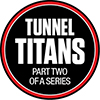
Yorkie beat Torkie, but only by a day. After 945 meters of digging southward, the first 6.4-m-dia tunnel-boring machine broke through the headwall of the extraction shaft at what will be Black Creek Pioneer Village Station on June 13. The next day, its twin TBM, nicknamed Torkie, followed. The earth-pressure-balance TBMs did not match the unusual feat of Nov. 12, when they completed—almost simultaneously—1.7 kilometers south from theBlack Creek shaft to a future Finch West Station site.
 |
The June breakthroughs—which were tweeted by the proud “parents” at the Toronto Transit Commission (TTC) at every stage of progress—mark the next-to-last leg of 6.7 km of twin tunneling for the $2.6-billion project. After this, Torkie and Yorkie will head north, enter a launch shaft at the Highway 407 site and dig the final 1.3 km to the northern end of the new line, which will link the city of Toronto with the municipality of York.
The 8.6-km-long Toronto York-Spadina Subway (TYSS) extension marks an ongoing revival of parts of a $5-billion, 25-year plan for Toronto's mass transit, slashed in 1995 by the provincial government. The sole survivor, the $577-million, 6.4-km-long Sheppard Subway, was completed in 2002. Four years later, the Ontario government announced it would invest $1 billion in transportation, with over half allocated for TYSS. Growing demand for transit helped spur the revival. "York University was growing, and the city of Vaughan wanted a line," says Joanna Kervin, TTC director of third party, planning and property. The federal government put in $697 million. Toronto and York are funding the rest of the $2.6 billion.
In 2010, TTC held open houses regarding the six station designs and awarded preliminary contracts. It also held a naming contest for the four TBMs, which, in advance of design, it had purchased from Caterpillar Inc. for $54 million. The results: Torkie, Yorkie, Holey and Moley. Holey began digging the southernmost tunnels from a launch shaft at an existing station in mid-2011, followed shortly by Moley. Yorkie began digging the northern tunnels in December, followed by Torkie in February 2012.
Construction was held up for four months after a worker was killed October 2011 by a toppled drill rig. Ontario's Ministry of Labor halted work at the Yori University station site and filed charges against the Madrid-based firms Obrascon Huarte Lain and FCC Construccion, along with drill-rig supplier Advanced Construction Techniques. The OHL-FCC joint venture made its Canadian debut in 2011 by winning the $410-million, lump-sum contract for the Highway 407 station, site excavation for the York University station and six kilometers of tunneling (ENR 2/28/11 p. 13). Legal proceedings are still under way.
The line's opening now is slated for 2016, instead of 2015, but the budget remains on track, and progress has been steady. Tunneling is 85% complete, and all contracts for station-related work are awarded, says Ted Zander, construction manager with the Spadina Link joint venture of Hatch Mott MacDonald, Delcan and MMM Group, construction manager for the TTC.
Design Deadline
Tunnel designers with Hatch Mott MacDonald faced a tight 18-month deadline—as opposed to a more typical two to three years—to produce the first bid documents, says Chris Tattersall, HMM project manager. The funding partners had hoped for the project to be completed in 2015, which necessitated the truncated design period, Kervin notes. The 18 months allocated for design also included concurrent geotechnical investigations by Golder Associates Ltd.
The 6.7 km of tunnels entail 8,500 precast-concrete lining rings totaling some 51,000 segments. Each ring consists of six trapezoidal segments, reinforced with steel bolts, dowels and guide rods. HMM used Bentley's solid-modeling computer-assisted-design software to model the rings, which had manufacturing tolerances of 1.5 millimeters for any segment over three meters long.
While this was HMM's first use of BIM on a subway project, it was more "evolutionary" than groundbreaking, Tattersall says. In addition to the fairly typical use of BIM for the alignment and its rarer use for the linings, "we took the step of using it also on utilities here. The utility information came in as 2D files, and we added the third dimension manually," he says. Since the alignment curves are "pretty tight here, we did a 3D mock-up in computer-assisted design of one of the junctions with an emergency-exit building, which is a shaft that comes up to grade," Tattersall says. "With that access stair, piping, electrical equipment plus the tight radius of curves, I needed to be sure it would all fit."




Post a comment to this article
Report Abusive Comment